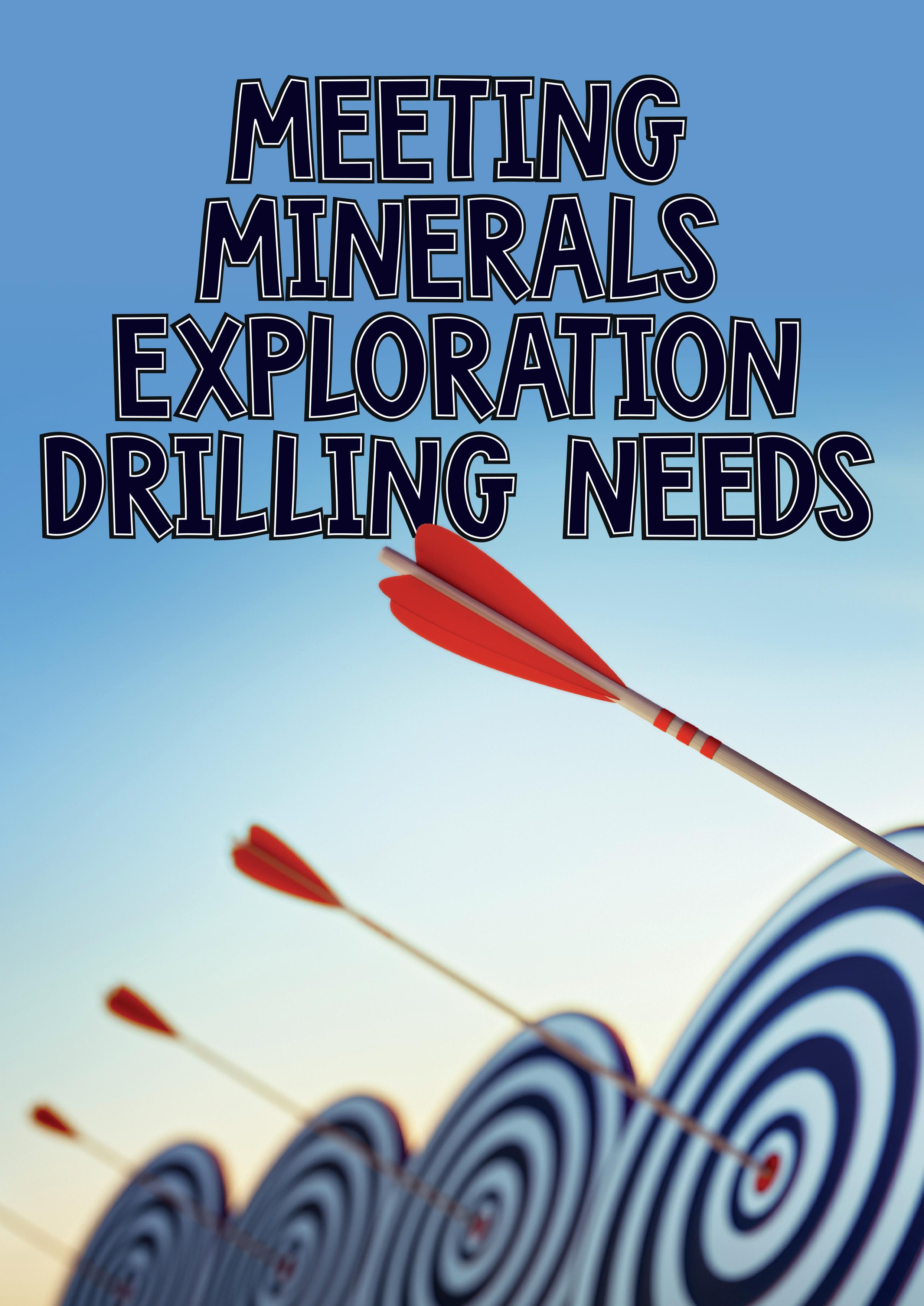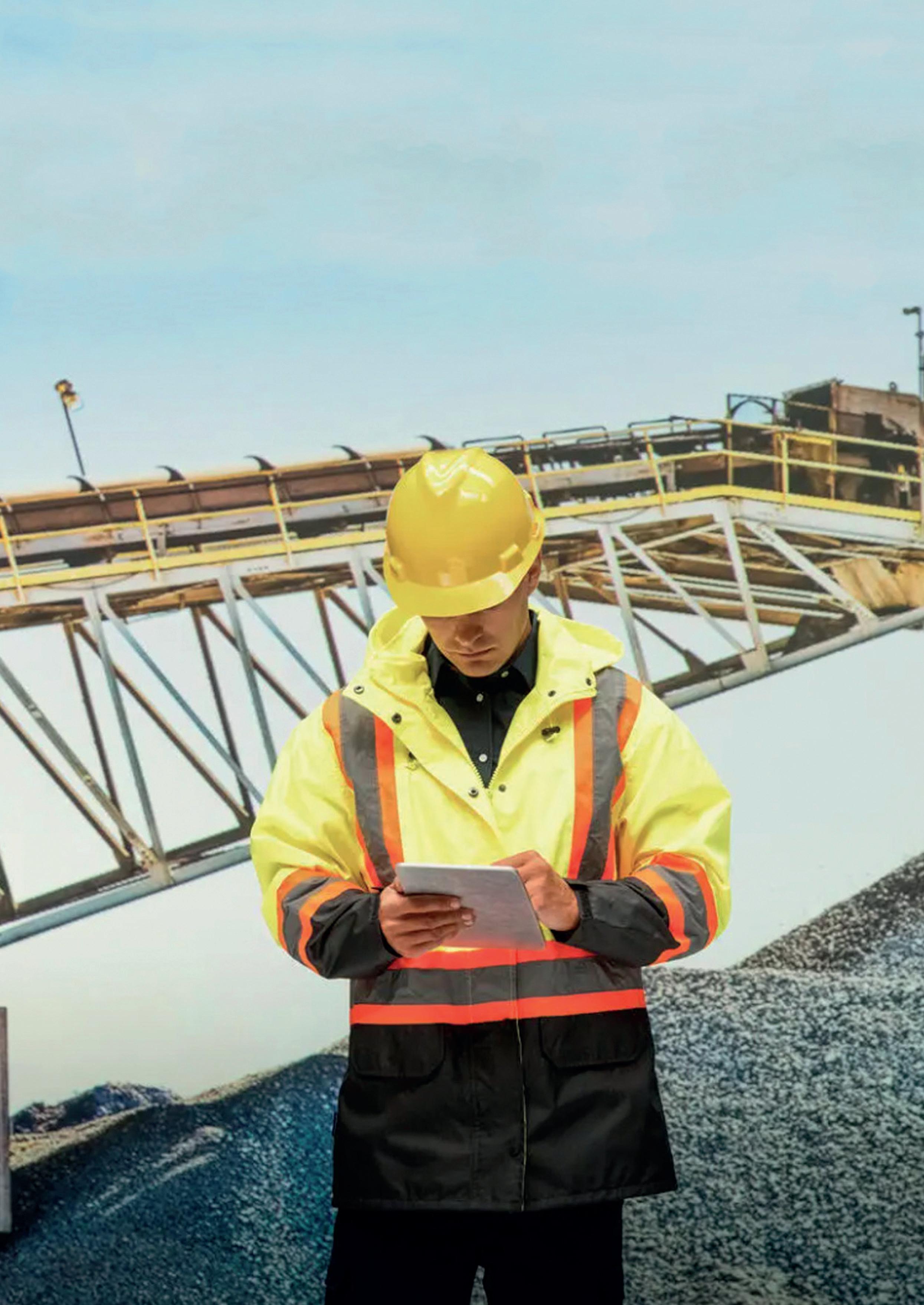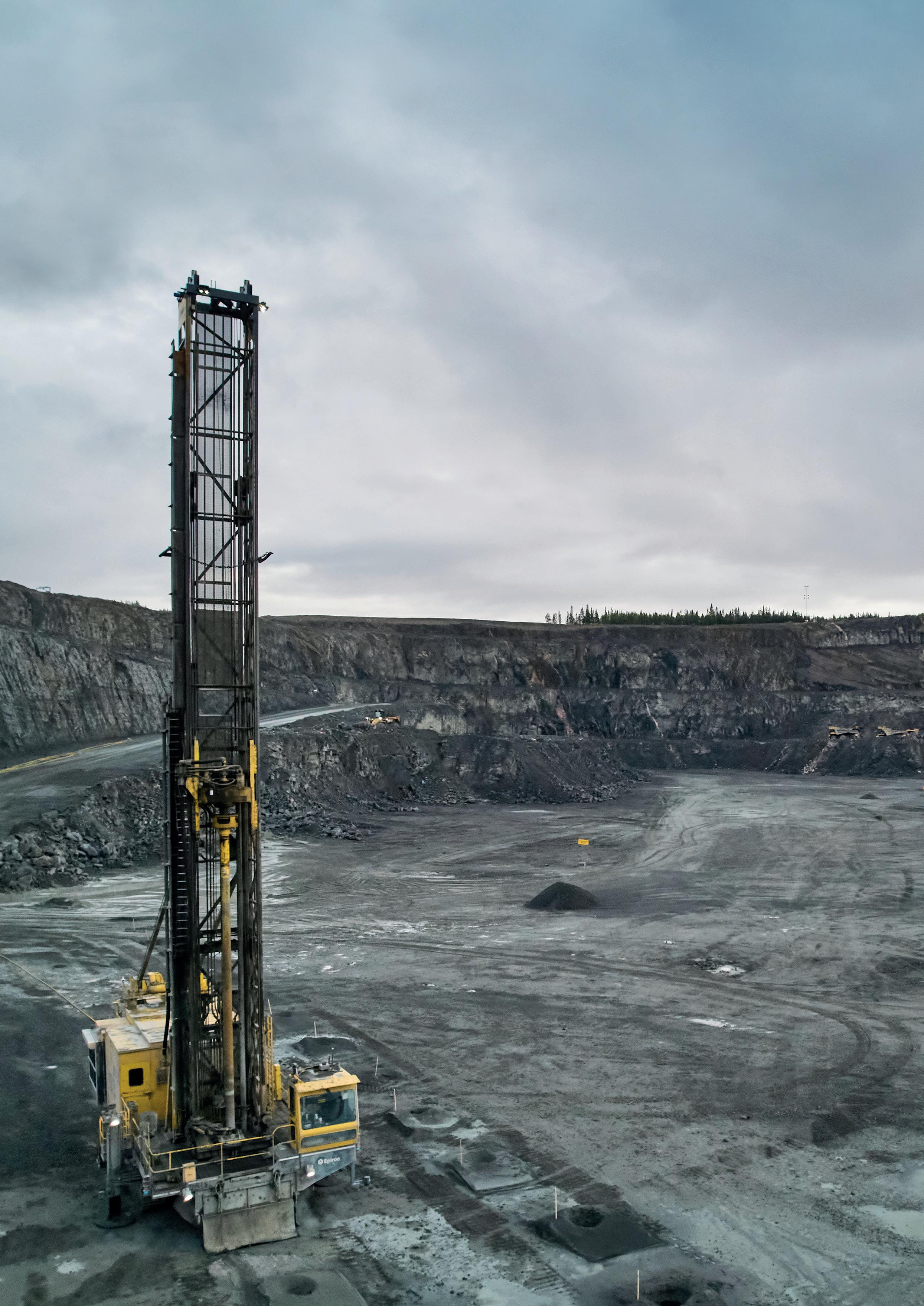
12 minute read
Doing Decarbonisation Right
Douglas Johnson-Poensgen, Circulor, UK, examines how mining companies can monitor their environmental impact and increasingly move toward more sustainable production by using supply chain traceability.
Today, the mining industry plays a key role in shifting to a low-carbon, electrified, battery-powered economy. Mining and material processing is not a straightforward process, and essentially, turning rock into battery-grade materials is enormously energy intensive. Therefore, decarbonising mineral extraction and processing is key to building a sustainable future.
Decarbonisation explained
Discussions around decarbonisation have become commonplace in almost every industry. The aim of decarbonising the environment is fundamental – it is about reducing carbon dioxide (CO2) emissions resulting from human activity, with an eventual goal of eliminating them completely.
The Paris Agreement set out a global framework to avoid dangerous climate change by limiting global warming to well below 2˚C, and pursuing efforts to limit it to at least 1.5˚C. Reducing global greenhouse gas emissions, including CO2, will limit the trend of rising global temperatures that the world has been experiencing over the past decades.
Mining processes
Mining practices tend to be complex and, at times, high risk to people and the environment if organisations are unaware of the details and dynamics at play within their supply chains. Circulor, for example, enables its customers to onboard and
connect each participant in their complex supply chains – from raw material extraction to the final product. The company tracks the material as it is mined and as it transforms from a commodity into an intermediate product, and then into the final product – such as an electric vehicle (EV) battery. Circulor uses a combination of technologies, including traditional database and blockchain, alongside business logic, to dynamically track the physical flow and physical transformation at every stage.
Decarbonisation of energy systems
Environmental issues have encouraged businesses to strive for a more sustainable, ethical, and eco-friendly way of producing essential minerals. One way to do this is to decarbonise energy systems. The World Economic Forum found that climate stabilisation requires full decarbonisation of the energy systems and net-zero greenhouse-gas emissions by approximately 2070, and mining plays a key role in this process.1 According to a report by McKinsey, “mining is currently responsible for up to 7% of greenhouse gas (GHG) emissions globally.”2
Electrifying the world
In order to reach net-zero emissions and decarbonise energy systems, participants should transition from using fossil fuels to renewables and alternative, low-carbon energy sources. Electrification of systems and resources, including transitioning transportation systems to EV drivetrains, can pave the way to achieving such goals. This is because EVs emit fewer greenhouse gases and air pollutants than petrol or diesel cars. Therefore, this is the most sustainable long-term solution.
However, while EVs have no tailpipe emissions, they have much larger resource and emission costs in the production phase. The production and manufacturing phase of an EV can create 70% more emissions than an internal combustion engine (ICE) vehicle, needing as many as nine years of EV driving to get back on par with an ICE.3
According to the International Energy Agency (IEA), a battery electric vehicle (BEV) needs six times more minerals than a conventional vehicle. With a growing number of EVs, there will also be an increasing need for batteries, and the critical materials used within these batteries, which will help fuel them.4 There will be a rise in lithium, cobalt and nickel, which are used to make the lithium-ion batteries required for EVs. The increase in EVs and the need for EV batteries with higher energy density will see demand for lithium grow more than threefold by 2025, while cobalt will increase by 60% over the same period, as reported by McKinsey.5 This further confirms the need for decarbonising mining and material production, and to ensure that it is achieved in the most environmentally conscious manner.

Figure 1. Authorised personnel being verified by Circulor facial recognition at a mine.
Figure 2. Miner scanning a Circulor QR code to trace raw materials.

What to consider when decarbonising mine sites
In theory, mining operations can be fully decarbonised through operational efficiency, electrification, and renewable-energy use.2 However, it is important to note that this will be dependent on many factors, such as location and access to capital.
First, it is key to understand that decarbonisation for mines varies by commodity, mine type, power source and grid emissions, among other factors. Across the industry, non-coal mines could fully decarbonise by using multiple levers2 – for example, moving to renewable sources of electricity is becoming increasingly feasible. Operational efficiency, for example, can make incremental improvements to the energy intensity of mining production while requiring little capital expenditure.
A wholesale transformation is advised, and accountability at the top can ensure organisations are ready to decarbonise their supply chains. Companies will need visibility on who buys and sells their ores, including traders and end customers, and how the minerals they mine are being used. New blockchain-enabled supply chain tracing methods are already being deployed to track the ethical sourcing of materials and they should readily be extendable into low-emissions mining.
What should organisations be prepared to do if they want to decarbonise their mine sites?
Leaders in the mining industry can take a step-by-step approach to decarbonise their mine sites. First, participants are encouraged to embrace change; this is often easier said than done, but can lead to environmental and economical growth. Then, understanding the impact of the company’s carbon footprint supports the decarbonisation process. Once this is identified, cost and
carbon savings can be made, which essentially increases the efficiency of equipment to reduce energy consumption. Next, investing in advanced technology is highly beneficial as it is a tool which leads to innovative ideas and changes. Finally, creating a sustainable supply chain will be possible. This could include changing the method of travel and the distance travelled in the transportation of goods. Partnering with other original equipment manufacturers (OEMs) and mining experts can also accelerate its success and positively impact the business and the environment.
Circulor, a leader in supply chain traceability, provides a holistic picture of the provenance of material and embedded carbon attributed to that material by dynamically tracking production and aggregating emissions at each step within the supply chain. Its service attributes carbon intensity to the tracked material, recording energy usage per facility and production volumes. With such accurate and valuable insight into the supply chain, those within the mining industry can successfully start to decarbonise their production processes.
What are key players in the mining industry doing?
Company leaders, OEMs, CEOs, and miners are collectively advised to make decisions which align with sustainability goals. Circulor has collaborated with industry experts who are welcoming change and tracking CO2 for the raw materials they are using.
Dealing with graphite
BlackEarth, a graphite developer, is working with Circulor to ensure data-driven proof of how they are bringing sustainable and responsibly produced graphite that can be trusted to market. A single EV contains 66.3 kg of graphite, according to the IEA, and with a growing number of EVs on the road, the world will need more graphite, meaning the production process of this graphite needs to be done sustainably and responsibly.6
Nickel consumption
Trafigura Pte Ltd is one of the world’s largest physical commodity trading companies. It is working with Circulor on traceability and CO2 tracking for its nickel trading division. This includes the dynamic tracking and attributing of CO2 emissions throughout Trafigura’s nickel supply chains for customers, in particular EV manufacturers.
Cobalt tracking
Volvo Cars are the first automaker to trace the cobalt supply chain using Circulor’s platform. It is decarbonising its mine sites by tracking recycled cobalt through manufacturing and transformation processes within the CATL supply chain. Doing so has enabled Volvo to validate the integrity of the material.
Manganese tracing
Element 25 Ltd and Circulor are partnering to establish full manganese traceability. Dynamic tracking of CO2 and environmental, social, and governance (ESG) standards for products produced from the Element 25 owned Butcherbird Project will be carried out. The company will also be able to document supply chain ESG credentials to downstream customers.
Copper transaction
BHP and Southwire – a leading US copper cable and wire manufacturer – are working with Circulor and have completed their first ‘carbon neutral’ copper transaction. This involved delivery from BHP’s mines in Chile to Southwire’s processing activities in Georgia, USA, and comprised tracing BHP copper cathodes and associated GHG emissions through to a finished product.
Tackling lithium
Canadian-German Rock Tech Lithium’s planned battery-grade lithium facility in Germany is expected to produce 24 000 tpy of lithium with the lowest possible environmental impact. Rock Tech Lithium is collaborating with Circulor on traceability and CO2 tracking for the refinery and its upstream suppliers. The end goal is to become Europe’s first closed-loop supplier of lithium hydroxide. Currently, only 1% of lithium from batteries is recycled worldwide. By 2030, Rock Tech Lithium aims to source 50% of its materials from recycled batteries.
Conclusion
If society truly wants to tackle climate change and decarbonise the planet, it is essential to start from the mine. Miners who want to meet and align with ESG goals of their downstream customers must have full visibility of their supply chains, which is possible through collaborating with platforms such as Circulor. There are miners who are already looking to differentiate their products through sustainability, as responsible sourcing poses a competitive advantage. New partnerships and markets will likely form over the coming years, and substances long emitted or discarded as costly nuisances can become products that companies want to invest in. A cleaner, more green economy can emerge when decarbonisation in the mining industry is done right.
References
1. ‘What’s the path to deep decarbonization?’, World Economic Forum, www.weforum.org/agenda/2015/12/whats-the-path-to-deepdecarbonization/ 2. ‘Climate risk and decarbonization: What every mining CEO needs to know’, McKinsey, www.mckinsey.com/business-functions/ sustainability/our-insights/climate-risk-and-decarbonization-whatevery-mining-ceo-needs-to-know 3. ‘Volvo says emissions from making EVs can be 70 percent higher’, This is Money, www.thisismoney.co.uk/money/cars/ article-10161697/Volvo-says-electric-car-making-emissions-70-
HIGHER-petrol.html 4. ‘Minerals used in electric cars compared to conventional cars’, International Energy Agency, www.iea.org/data-andstatistics/charts/minerals-used-in-electric-cars-compared-toconventional-cars 5. ‘Lithium and cobalt – a tale of two commodities’, McKinsey, https://mck.co/3mprzUc 6. ‘The Role of Critical Minerals in Clean Energy Transitions’,
International Energy Agency, www.iea.org/reports/the-role-ofcritical-minerals-in-clean-energy-transitions/executive-summary






JENNMAR designs and manufactures a wide range of dependable ground control products, from bolts and beams to channels and trusses, resin, rebar, and more. We’re proud to make products that make the mining, tunneling, civil, and construction industries safer and more efficient. Because we understand the ever-changing and demanding conditions above and below ground we have built the richest portfolio of diverse and complementary brands. JENNMAR sets the bar in every industry we serve and as we continue to grow, our focus will always be on the customer. We feel it is essential to develop a close working relationship with every customer so we can understand their unique challenges and ensure superior customer service. Our commitment to the customer is guided by three words: SAFETY, SERVICE, and INNOVATION. It’s these words that form the foundation of our business. It’s who we are.































DEMANDING CONDITIONS DEMAND
JENNMAR




































